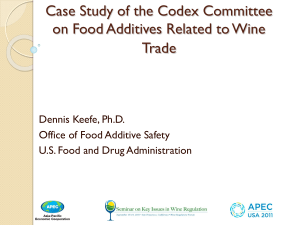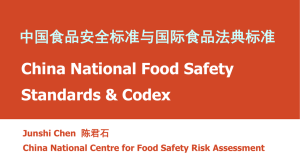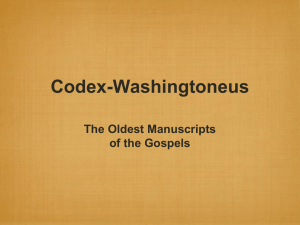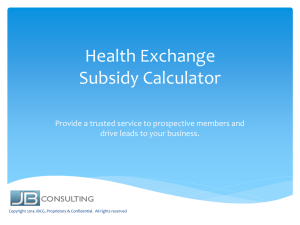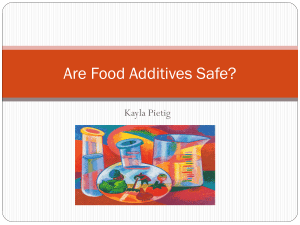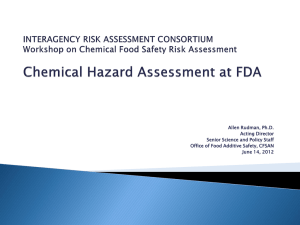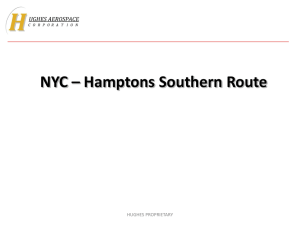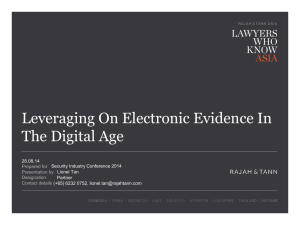Global Harmonization of Food Ingredient Specifications
advertisement
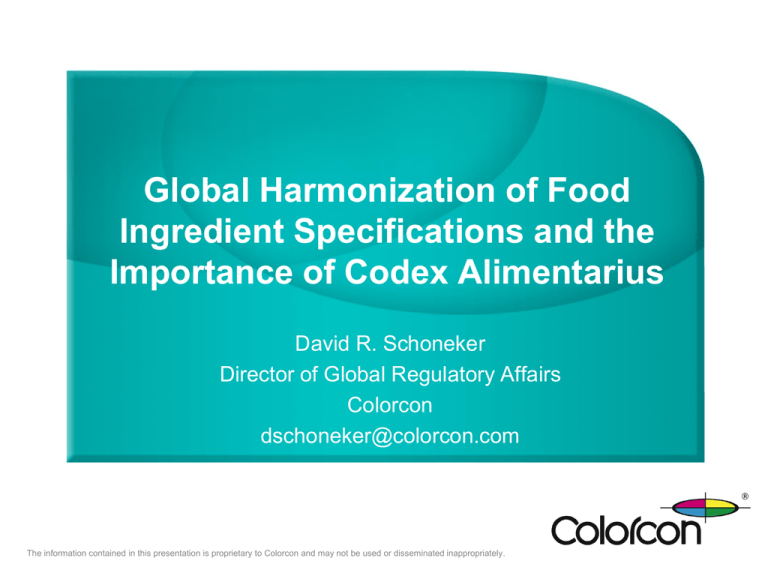
Global Harmonization of Food Ingredient Specifications and the Importance of Codex Alimentarius David R. Schoneker Director of Global Regulatory Affairs Colorcon dschoneker@colorcon.com The information contained in this presentation is proprietary to Colorcon and may not be used or disseminated inappropriately. The Need for Harmonization of Food and Color Additive Specifications Food regulations in many countries provide lists of approved food and color additives for various food categories, acceptable levels of use and specifications for these materials These lists, food categories and specifications are extremely non-harmonized around the world which makes it very difficult for international trade of many food products Major developed countries such as the U.S. Europe and Japan have had detailed food and color additive regulatory systems in place for many years which has led to significant nonharmonized standards Currently, many developing countries are in the process of improving their regulations related to food and color additives in a non-harmonized manner which is increasing the problems The information contained in this presentation is proprietary to Colorcon and may not be used or disseminated inappropriately. The information contained in this presentation is proprietary to Colorcon and may not be used or disseminated inappropriately. Codex Committee on Food Additives (CCFA) Global food standards setting committee Goal: harmonized food standards CCFA is developing a General Standard for Food Additives (GSFA) that lists food additives reviewed and assigned an Acceptable Daily Intake (ADI) (either numerical or "not specified") by JECFA. The GSFA provides a list of food categories for which an additive may be used and the maximum level of use for each category. The information contained in this presentation is proprietary to Colorcon and may not be used or disseminated inappropriately. JECFA Joint FAO/WHO Expert Committee on Food Additives International expert scientific committee that is administered jointly by the Food and Agriculture Organization of the United Nations (FAO) and the World Health Organization (WHO) Global body that performs toxicological evaluations (risk assessment and exposure assessment) The information contained in this presentation is proprietary to Colorcon and may not be used or disseminated inappropriately. JECFA Meet once a year to review food additive safety data submitted Works in conjunction with Codex Committee on Food Additives (CCFA) Has evaluated more than 2,500 food additives The information contained in this presentation is proprietary to Colorcon and may not be used or disseminated inappropriately. General Standard for Food Additives (GFSA) Has 16 food categories, most with subcategories (hierarchical), that lists food additives and maximum level allowed for use in each food category Organized in three tables: — Table 1: Organized by Food Additive — Table 2: Organized by Food Category — Table 3: Additives for which an ADI of “non-specified” (previously called ADI “not-limited”) has been assigned; additives permitted for use at GMP’s, except for food categories listed in the Annex The information contained in this presentation is proprietary to Colorcon and may not be used or disseminated inappropriately. General Standard for Food Additives Initial Charge to the Committee 1991 Elaborate a GSFA that includes all foods Develop the GSFA 1. CCFA should agree to accept science-based JECFA safety evaluations 2. CCFA should recognize variability of technological need among different nations 3. CCFA should not rely on individual government prohibitions on additives in specified foods, yet instead should rely more heavily on informative labeling 4. CCFA members should rely on the GSFA as the single authoritative source on food additives The information contained in this presentation is proprietary to Colorcon and may not be used or disseminated inappropriately. GSFA – Food Additive Provisions The information contained in this presentation is proprietary to Colorcon and may not be used or disseminated inappropriately. Note 161 Note 161 undermines: — scientific base of Codex and — foundation of Codex as an international standard setting organization — and is inconsistent with WTO SPS agreement regarding scientific justification…“national governments can adopt more restrictive standards than those of Codex if there is scientific justification” and “Codex standards are voluntary and national governments may introduce a higher level of protection when justified” Codex “STATEMENTS OF PRINCIPLE CONCERNING THE ROLE OF SCIENCE IN THE CODEX DECISION-MAKING PROCESS AND THE EXTENT TO WHICH OTHER FACTORS ARE TAKEN INTO ACCOUNT” — Recognized that some legitimate concerns of governments when establishing their national legislation are not generally applicable or relevant worldwide — Only those factors which can be accepted on a worldwide basis, or on a regional basis in the case of regional standards and related texts, should be taken into account in the framework of Codex The information contained in this presentation is proprietary to Colorcon and may not be used or disseminated inappropriately. JECFA Evaluation of Aluminum June 2006 Aluminum evaluated from all sources including food and color additives Based on limited data which was available JECFA established a provisional tolerable weekly intake (PTWI) of 1 mg/kg bw for all aluminum compounds JECFA withdrew previous PTWI of 0-7 mg/kg bw Committee concluded that aluminum has the potential to effect the reproductive system and developing nervous system at doses lower then previous PTWI Committee requested additional safety data on bioavailability of different aluminum containing additives, developmental study and a multigeneration study with neurobehavioural endpoints The information contained in this presentation is proprietary to Colorcon and may not be used or disseminated inappropriately. Industry Study Conclusions Bioavailability studies conducted by trade associations (IFAC, IACM and IAI) for 7 compounds The IAI Industry association submission to JECFA concluded the following: — “In light of recent studies that either filled toxicological data gaps or reduced uncertainty in the toxicokinetic differences between test animals and humans, raising the value of the PTWI by a factor of up to 4 would be consistent with the currently available scientific data.” IAI stated uncertainty factors already applied may be considered sufficient to address remaining data gaps and uncertainties. The information contained in this presentation is proprietary to Colorcon and may not be used or disseminated inappropriately. JECFA Evaluation June 2011 The new industry studies were submitted for evaluation of bioavailability, reproductive, developmental and neurobehavioural effects JECFA Committee then established a PTWI of 2 mg/kg bw; the previous PTWI of 1 mg/kg bw was withdrawn Recommended that the provisions in the GSFA be compatible with the revised PTWI New data did not substantially change the LOAEL range of 5075 mg/kg bw per day; a NOAEL of 30 mg/kg bw per day from an aluminum citrate study was used to determine the revised PTWI of 2 mg/kg bw The information contained in this presentation is proprietary to Colorcon and may not be used or disseminated inappropriately. European Union Evaluation of Aluminum EFSA evaluation established a tolerable weekly intake (TWI) of 1 mg/kg bw in 2008 EU Commission than began drafting restrictions on the level of use of aluminum from food additives in various food categories to address the reduced TWI In 2010 EFSA refused to increase the TWI based on the new industry studies and on JECFA’s revised TWI — If they used JECFA’s preliminary assessment to lower the TWI, why shouldn’t they use JECFA’s final assessment to increase and align the EU TWI with global standards? Instead, the EU Commission officially amended Annex II of regulation 1333/2008 to limit aluminum content in various food categories - Effective 1 August 2014 The information contained in this presentation is proprietary to Colorcon and may not be used or disseminated inappropriately. Future Considerations to Improve Harmonization Increased participation from all Codex members and commitments to accept Codex standards will: — Ensure consumer health protections, and fair trade practices — Ensure science-based international standards that are good for government, industry, and consumers — Promote harmonization through stakeholder consultations — Promote technical advancements to build market opportunities Increased funding is needed for JECFA to facilitate timely safety reviews and specification development — How can this be done within the current government funding paradigm? — Should industry and governments (U.N.) consider some type of user fee approach? — This has worked well in the U.S. for certified colors! — How can we get this discussion started? The information contained in this presentation is proprietary to Colorcon and may not be used or disseminated inappropriately. Acknowledgements Maia Jack – GMA Penny Marsh – Kerry Haley Stevens – IFAC Chris DeMerlis - Colorcon The information contained in this presentation is proprietary to Colorcon and may not be used or disseminated inappropriately.
